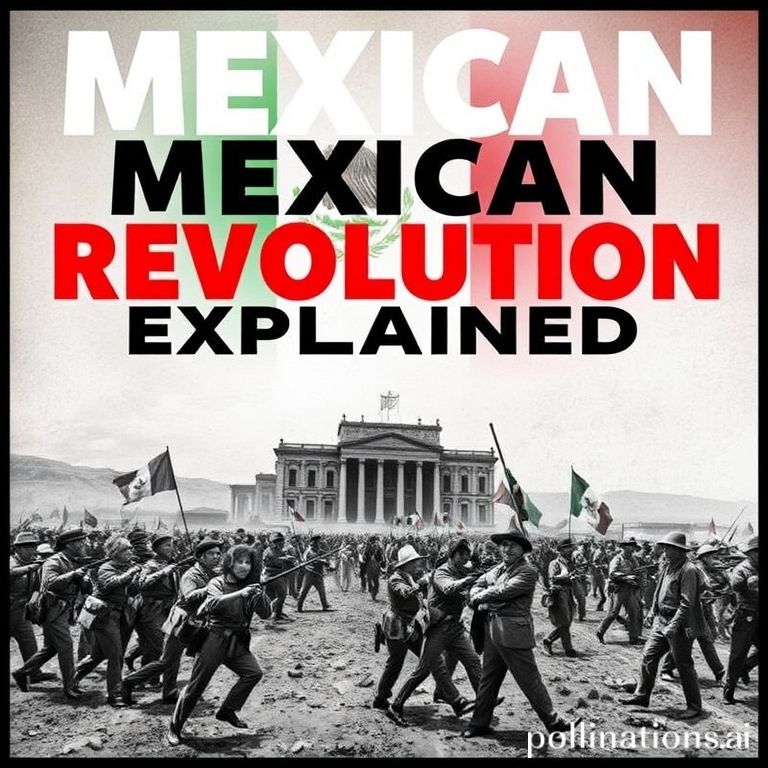The Mexican Revolution, a pivotal moment in Mexican history, often seems complex and daunting to understand. Spanning from 1910 to 1920, this transformative period was characterized by widespread social unrest, political upheaval, and armed conflict. But beneath the surface of complex historical narratives lies a relatively straightforward story of a nation yearning for change.
In this article, we aim to demystify the Mexican Revolution, providing a clear and concise explanation of its causes, key players, and lasting impacts. Whether you’re a history enthusiast or simply curious about Mexican culture, understanding the revolution is crucial to grasping the country’s identity today. We’ll break down the key events and figures, making this important piece of history accessible and engaging.
The Seeds of Revolution: Inequality and Discontent
The Mexican Revolution wasn’t a spontaneous event; it was the culmination of decades of simmering discontent. Under the long rule of President Porfirio Díaz, Mexico experienced significant economic growth, but this prosperity was not shared equally. Díaz’s policies favored wealthy landowners and foreign investors, leaving the vast majority of Mexicans, particularly the rural peasantry, in abject poverty.
Land Ownership and Exploitation
- Land Concentration: A small elite controlled most of the land, leaving peasants landless and forced to work on large estates (haciendas) under exploitative conditions.
- Economic Disparity: The gap between the rich and poor widened dramatically, creating deep resentment and fueling social unrest.
- Political Repression: Díaz’s regime was authoritarian, suppressing dissent and limiting political participation, further alienating the population.
Key Figures and Their Ideologies
The revolution saw the rise of several influential figures, each with their own vision for Mexico’s future. Understanding their ideologies is crucial to understanding the revolution itself.
Francisco I. Madero: The Idealist
Madero, a wealthy landowner himself, initially sought political reform through democratic means. His call for free and fair elections in 1910 ignited the revolution. While his intentions were noble, Madero lacked the ruthlessness and political savvy to navigate the turbulent waters of the revolution. He was later assassinated in 1913, further destabilizing the country.
Emiliano Zapata: Champion of the Peasants
Zapata, a charismatic leader from the southern state of Morelos, became the symbol of the peasant struggle for land reform. His rallying cry, “Tierra y Libertad” (Land and Liberty), resonated with the dispossessed. Zapata’s vision was simple: to return land to the indigenous communities from whom it had been stolen. His Plan de Ayala, a radical agrarian reform program, became a cornerstone of revolutionary ideology.
Pancho Villa: The Northern Centaur
Villa, a legendary figure from the northern state of Chihuahua, was a brilliant military strategist and a popular hero among the working class. He led his División del Norte (Northern Division) in a series of spectacular victories against the federal army. While Villa’s methods were often brutal, his commitment to social justice and his defiance of the established order made him a powerful force in the revolution.
The Course of the Revolution: A Decade of Conflict
The Mexican Revolution was not a single, unified movement; it was a complex and often chaotic series of conflicts between different factions vying for power. The decade-long struggle was marked by violence, betrayal, and shifting alliances.
The Overthrow of Díaz and Madero’s Presidency
Madero’s call for revolution in 1910 led to the overthrow of Porfirio Díaz in 1911. However, Madero’s presidency was short-lived and ineffective. He failed to address the underlying issues of land reform and social inequality, alienating both Zapata and Villa.
The Rise of Carranza and Obregón
Following Madero’s assassination, Venustiano Carranza, a wealthy landowner, emerged as a leading figure. Carranza, supported by General Álvaro Obregón, sought to restore order and establish a constitutional government. However, his vision for Mexico was more conservative than that of Zapata and Villa, leading to continued conflict.
The Constitution of 1917: A Revolutionary Document
Despite the ongoing violence, the revolution produced one of its most enduring legacies: the Constitution of 1917. This landmark document enshrined many of the revolution’s key demands, including land reform, workers’ rights, and limitations on foreign ownership. While the constitution was not fully implemented immediately, it laid the foundation for a more just and equitable society.
The Legacy of the Mexican Revolution
The Mexican Revolution had a profound and lasting impact on Mexican society, politics, and culture. It reshaped the country’s social fabric, empowered the working class and peasantry, and laid the groundwork for a more democratic and inclusive society. While the revolution was a period of great upheaval and violence, it ultimately paved the way for a more just and equitable Mexico.
Conclusion
The Mexican Revolution, though complex, can be understood as a struggle for social justice and equality. Fueled by deep-seated inequality and led by iconic figures like Zapata and Villa, the revolution transformed Mexico. The Constitution of 1917 stands as a testament to the revolution’s enduring legacy, shaping Mexico’s identity and future. Understanding this period is vital to appreciating the complexities and richness of Mexican history and culture.
If you found this explanation helpful, share it with your friends and family and continue exploring the fascinating history of Mexico on Life in Mexico!
IMAGE: A sepia-toned photograph depicting Emiliano Zapata leading a group of armed peasants. The scene is set in rural Mexico, with a dusty landscape and adobe buildings in the background. Zapata is wearing his signature sombrero and ammunition belts. The mood is determined and hopeful, with a sense of revolutionary fervor. The style is reminiscent of historical documentary photography.


